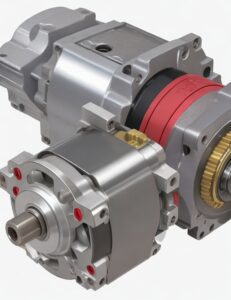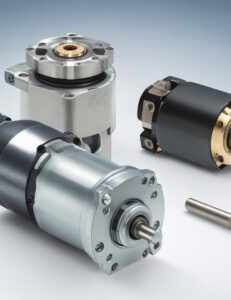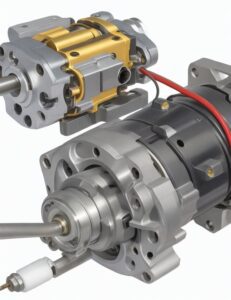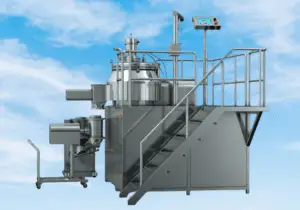A Direct Drive Motor, also known as a direct-drive or torque motor, is an electric motor technology that offers a direct mechanical connection between the motor and the driven load. Unlike traditional motors that employ gears or transmission systems to transfer power, direct drive motors eliminate the need for intermediate components, allowing the motor’s output shaft to be directly connected to the load.
Principle of the Direct Drive Motors:

The principle of Direct Drive Motors revolves around the concept of directly coupling the motor to the driven load, eliminating the need for intermediary components like gears or transmission systems. This design philosophy is rooted in the pursuit of enhanced efficiency, precision, and responsiveness in electric motion systems.
The core principle of Direct Drive Motors can be summarized as follows:
- Elimination of Mechanical Gearing: Unlike traditional motors that employ gears to transfer power and control motion, Direct Drive Motors eschew this intermediary step. By directly connecting the motor’s rotor to the driven load, the motor’s output is transferred without any mechanical backlash, ensuring a smoother and more precise motion.

- Integration of Stator and Rotor: Direct Drive Motors integrate the stator and rotor components, either by embedding magnets in the rotor or using a magnetized rotor in close proximity to the stator. This arrangement creates a strong magnetic field interaction, resulting in torque generation and motion without the need for physical contact between rotor and stator.
- Enhanced Efficiency and Reduced Friction: With fewer moving parts and no mechanical gears, the friction and mechanical losses common in traditional motors are greatly reduced in Direct Drive Motors. As a result, these motors demonstrate higher energy efficiency and have a longer lifespan due to decreased wear and tear.
- Precise and High-Speed Control: The elimination of mechanical gearing allows for more precise and high-speed control of motion. This level of precision is crucial in applications requiring fine adjustments and rapid changes in speed or direction.
- Quieter Operation: The absence of gears and transmission components results in quieter operation, making Direct Drive Motors ideal for applications where noise reduction is essential, such as in medical devices or noise-sensitive environments.
- Increased Responsiveness: Direct Drive Motors exhibit enhanced responsiveness due to the direct connection between the motor and load. They can rapidly change speed and direction, providing quick and accurate responses to control inputs.
- Versatility Across Industries: The principle of Direct Drive Motors lends itself to a wide range of applications across various industries, including robotics, automation, precision manufacturing, aerospace, medical devices, and renewable energy.
In essence, the principle of Direct Drive Motors embraces simplicity, efficiency, and precision, revolutionizing electric motion technology by providing seamless and direct power transfer for an array of high-performance applications.
Components of the Direct Drive Motors

| Major Components | Description |
|---|---|
| Stator | The stationary part of the motor, consisting of coils |
| or windings that generate a magnetic field. | |
| Rotor | The moving part of the motor, which contains magnets |
| that interact with the stator’s magnetic field. | |
| Bearings | Bearings support and guide the rotor’s rotation, |
| reducing friction and enabling smooth motion. | |
| Feedback Sensors | These sensors provide feedback on the motor’s position, |
| speed, and torque, allowing for precise control. | |
| Resolver/Encoder | Common types of feedback sensors used in Direct Drive |
| Motors for position and velocity feedback. | |
| Power Electronics | The electronic components responsible for controlling |
| the flow of current to the motor’s windings. | |
| Cooling System | For some high-performance applications, direct drive |
| motors may require cooling systems to dissipate heat. | |
| Mechanical Interface | The part that connects the rotor to the driven load, |
| transmitting the motor’s motion to the application. |

Types of the Direct Drive Motor:
Direct drive motors come in different types, each tailored to specific applications and motion requirements. Here are the main types of direct-drive motors:
- Direct Drive Rotary Motors:
- Torque Motors: These motors offer high torque output and are commonly used in applications requiring precise rotary motion, such as machine tools, rotary tables, and printing presses.
- Brushless Direct Drive Motors: Also known as brushless servo motors, these provide smooth and accurate motion control, making them ideal for robotics, automation, and semiconductor manufacturing.
- Direct Drive Linear Motors:
- Ironless Linear Motors: These motors are known for their high acceleration capabilities and low cogging, making them suitable for applications like pick-and-place machines, semiconductor wafer handling, and high-speed transportation systems.
- Iron-Core Linear Motors: Featuring higher force densities and lower thermal resistance, these motors are used in applications where higher forces and continuous duty cycles are required, such as industrial automation and precision machining.
- Voice Coil Motors (VCM):
- Voice coil actuators use the Lorentz force principle to produce a linear motion. They are commonly found in applications like autofocus mechanisms in cameras, optical devices, and medical equipment.

- Linear Resonant Actuators (LRA):
- LRAs are used to create tactile feedback in haptic devices, smartphones, and wearables. They offer precise and controlled vibrations, enhancing user experience.
- Direct Drive Wind Turbine Generators:
- These motors are directly integrated into the wind turbine’s blades or hub, eliminating the need for a gearbox. By improving efficiency and reducing maintenance, they contribute to the advancement of renewable energy.
- Direct Drive Linear Generators:
- Linear generators convert linear motion directly into electrical power. They find applications in wave energy converters, linear wave generators, and regenerative braking systems.
Each type of direct drive motor has unique characteristics and advantages, making them suitable for diverse industries and applications. The choice of a direct drive motor depends on factors such as required torque, speed, precision, and environmental conditions, allowing engineers to tailor the technology to specific needs in the modern world of automation and high-precision machinery.
Advantages of a Direct Drive Motor:
| Advantages of Direct Drive Motor |
|---|
| 1. Eliminates Mechanical Backlash |
| 2. Enhanced Precision |
| 3. Reduced Mechanical Losses |
| 4. Increased Efficiency |
| 5. Whisper-Quiet Operation |
| 6. Unmatched Responsiveness |
| 7. High-Speed Maneuverability |
| 8. Seamless Torque and Speed |
| 9. Ideal for Robotics and Automation |
| 10. Precision Manufacturing |
| 11. Green and Sustainable Solution |
| 12. Less Wear and Tear |
| 13. Low Maintenance |
| 14. Longer Lifespan |
| 15. Enhanced Energy Conversion |
Applications of the Direct Drive Motors:
| Applications | Description |
|---|---|
| Robotics | Direct Drive Motors are widely used in robotic systems for precise and smooth motion control, enhancing the robot’s agility and accuracy. From industrial robots to humanoid robots, they play a vital role in automation. |
| Machine Tools | In the realm of manufacturing, direct drive motors are utilized in machine tools such as CNC machining centers and lathes to provide high-speed and high-precision machining capabilities, reducing cycle times and improving overall efficiency. |
| Semiconductor Manufacturing | Direct Drive Motors find applications in semiconductor manufacturing equipment like wafer handlers, aligners, and lithography systems, ensuring precise positioning and alignment during the manufacturing process. |
| Aerospace and Defense | In aerospace and defense industries, these motors are employed in flight simulators, missile systems, and antenna positioning systems, enabling swift and accurate movements essential for critical operations. |
| Medical Devices | Direct Drive Motors contribute to the precision and flexibility of medical devices such as robotic surgical systems, MRI machines, and lab automation equipment, enhancing patient care and medical research. |
| Direct Drive Wind Turbines | These motors are integrated directly into wind turbines, eliminating the need for gearboxes. They enhance energy conversion efficiency, reduce maintenance, and contribute to the growth of renewable energy. |
| Electric Vehicles | Direct Drive Motors play a role in electric vehicles, powering the wheels directly for improved efficiency and responsiveness, resulting in a smoother and quieter driving experience. |
| Aerospace Actuators | In the aerospace industry, direct drive motors are utilized in actuator systems for control surfaces, thrust vectoring, and flight control, ensuring precise and rapid adjustments during flight. |
| Robotics and Prosthetics | In robotics and prosthetic limbs, direct drive motors offer natural and precise movements, enabling advanced assistive technologies for people with mobility challenges. |
| High-Precision Positioning Systems | In applications requiring exceptional precision, such as optical and laser systems, direct drive motors deliver the accuracy needed for tasks like laser cutting, scanning, and alignment. |
Frequently Asked Questions:
Is direct drive motor AC or DC?
Answer: Direct drive motors can be both AC (alternating current) and DC (direct current). The type of direct-drive motor used depends on the specific application and requirements. AC direct-drive motors are often used in high-power applications, while DC direct-drive motors are preferred for their precise control and responsiveness.
What is the benefit of direct drive motor?
Answer: The benefits of direct-drive motors include:
- Efficiency: Direct-drive motors eliminate the need for mechanical gears and transmission components, resulting in higher energy efficiency as there are fewer energy losses.
- Precision: With no mechanical backlash, direct-drive motors offer superior precision and accuracy in motion control, making them ideal for applications that demand precise positioning and movements.
- Reduced Maintenance: The simplicity of direct-drive motors, with fewer moving parts and no gears, leads to reduced maintenance needs and longer operational lifespans.
- Quiet Operation: Direct-drive motors produce less noise compared to geared systems, making them suitable for applications where low noise levels are crucial.
- Faster Response: The direct connection between the motor and the load allows for quicker response times, enabling rapid changes in speed and direction, vital in applications requiring dynamic performance.
What is the disadvantage of direct drive motor?
Answer: While direct-drive motors have numerous advantages, they also have some disadvantages:
- Cost: Direct-drive motors can be more expensive to manufacture and purchase compared to traditional geared motors due to their specialized design and high-performance features.
- Size and Weight: In some cases, direct-drive motors may be larger and heavier than equivalent geared motors, which can be a consideration in space-constrained applications.
- Control Complexity: Achieving precise control in direct-drive motors may require more sophisticated control algorithms and sensors, adding complexity to the overall system.
- Thermal Considerations: High-performance direct-drive motors can generate more heat, necessitating effective cooling systems for certain applications.
What is a Direct Drive Motor?
Answer: A Direct-Drive Motor is an electric motor technology that directly connects the motor’s rotor to the driven load, eliminating the need for mechanical gears or transmission components.
How do Direct Drive Motors achieve higher efficiency?
Answer: Direct-Drive Motors achieve higher efficiency by reducing energy losses associated with mechanical gears, resulting in improved power transfer to the load.
What applications benefit from using Direct Drive Motors?
Answer: Direct-Drive Motors find applications in robotics, automation, machine tools, semiconductor manufacturing, medical devices, and renewable energy systems, among others.
How does the absence of mechanical gearing in Direct Drive Motors impact precision?
Answer: The absence of mechanical backlash in Direct-Drive Motors allows for superior precision and accuracy in motion control and positioning tasks.
What advantage do Direct Drive Motors offer in terms of maintenance?
Answer: Direct-Drive Motors typically require less maintenance due to their simplified design, which results in fewer moving parts and reduced wear and tear.
How do Direct Drive Motors contribute to noise reduction?
Answer: Direct-Drive Motors produce less noise compared to geared systems because they lack mechanical gears that can generate vibrations and noise during operation.
What are some typical industries that benefit from using Direct Drive Motors?
Answer: Industries such as manufacturing, aerospace, medical, robotics, renewable energy, and precision motion control extensively use Direct-Drive Motors.
How do Direct Drive Motors enhance dynamic performance?
Answer: Direct-Drive Motors can rapidly change speed and direction, offering exceptional dynamic performance critical for agile and responsive systems.
What types of feedback sensors are commonly used in Direct Drive Motors?
Answer: Feedback sensors like encoders and resolvers are commonly used in Direct-Drive Motors to provide position, velocity, and torque feedback for precise control.
What are the main disadvantages of Direct Drive Motors?
Answer: Some disadvantages of Direct-Drive Motors include higher initial costs, potential thermal challenges in high-performance applications, and added complexity in control algorithms.

